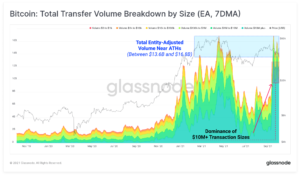HodlX Guest Post Submit Your Post
Over the last five years, the Lightning Network has emerged as the technology solution to the Bitcoin scalability issue.
However, its development has been slow and faced significant obstacles such as a lack of liquidity and potential risks.
Addressing these hurdles will require a collaborative effort between centralized and decentralized solutions, paving the way for wider Lightning Network adoption and increased Bitcoin usage.
I see these problems of Lightning Network clearly but first, let’s take a look at the numbers.
Lightning Network tatistics
For now, the Lightning Network protocol has over 16,000 nodes, with a total of 75,647 payment channels. Since 2020, the number of nodes has increased by 240%.
The current network capacity is over 5400 BTC, with the average node capacity at 0.333 BTC.
According to a recent study, the majority of the nodes are located in developed countries. Germany, Canada and the Netherlands have nearly 10,000 nodes between them, while roughly half of all existing nodes are based in the US.
Lightning Network apps (LApps) or LN wallets provide access to off-chain transaction channels. Currently, there are over 70 LApps or wallets across the market.
Exploring the risks
Although LN’s popularity and adoption are increasing, it features some risks users might be unaware of.
First, LN channels are fundamentally anonymous and decentralized, meaning the responsibility is shared solely by the parties involved.
This creates a massive concern in case one of the parties turns out to be a bad actor (e.g., when both parties are in the payment channel, one may close the channel and pocket the funds while the other party is offline).
Second, as all transactions are recorded off-chain except the last settlement, all funds may be lost if any participant closes the channel. This issue goes against the fundamental principle of blockchain technology, which is to ensure transparency.
Third, there’s the risk of malicious cyberattacks that can disrupt transactions and increase network congestion.
A report by the Florida International University showed that malicious bots could be configured to attack Lightning Network channel servers.
By breaching the network, they can create several channels and close them simultaneously, resulting in massive congestion and providing a window of opportunity for hackers to steal funds from their targets.
And fourth, there’s the risk of the counterparty default. If one of the participants does not have enough funds to cover their balance, the transaction will fail, and the funds will be lost.
How can operators improve the Lightning Network
These risks and concerns hold back the broader potential of LN. The first step to securing the network is improving user knowledge and experience for example, by making LN channels easy to set up and use.
Also, there should be a strong emphasis on improving node quality. Many operators manage their nodes through special advanced software ecosystems, but they must balance their channels properly.
This reduces the network speed, slowing down transactions and spoiling LN’s fundamental use case.
And lastly, what the LN could use is a cheap plug-and-play device that users could just plug into an electric socket and easily set up, so it would automatically optimize all network configurations and node performance.
On the road to adoption
Overall, the Lightning Network was created as a solution to the scalability issues of the Bitcoin network, making transactions faster, cheaper and more efficient.
However, these benefits will not be widely received if the current risks and liquidity issues continue to exist.
Therefore, operators and developers must improve the user experience and security features of LN platforms going forward and introduce effective solutions to LN if they were to grow their adoption across other regions.
Ultimately, we observe a correlation between the rise of layer two solutions and transaction fees in layer one.
This trend is particularly evident in Ethereum, where the surge in average gas prices from 2020 to 2022 prompted many developers to explore layer two solutions. This resulted in the rise of new layer two scaling solutions.
However, the transaction fees on the Bitcoin network are not as significant, leading most users to rely on the native layer.
That’s why it’s crucial to solve the inner problems of the sector to grab potential users and be the best market-fit solution if the network transaction fees rise.
Slava Demchuk is a co-founder of AMLBot, CEO of PureFi and founder of AMLSafe, companies that specialize in crypto AML/KYC compliance and security. Slava is an experienced C-level executive, visionary and AML specialist, certified by the EIMF (European Institute of Management and Finance).
Follow Us on Twitter Facebook Telegram
Check out the Latest Industry Announcements 
Disclaimer: Opinions expressed at The Daily Hodl are not investment advice. Investors should do their due diligence before making any high-risk investments in Bitcoin, cryptocurrency or digital assets. Please be advised that your transfers and trades are at your own risk, and any loses you may incur are your responsibility. The Daily Hodl does not recommend the buying or selling of any cryptocurrencies or digital assets, nor is The Daily Hodl an investment advisor. Please note that The Daily Hodl participates in affiliate marketing.
Featured Image: Shutterstock/local_doctor
- SEO Powered Content & PR Distribution. Get Amplified Today.
- Platoblockchain. Web3 Metaverse Intelligence. Knowledge Amplified. Access Here.
- Source: https://dailyhodl.com/2023/04/03/is-bitcoins-lightning-network-adoption-in-jeopardy-liquidity-and-risk-issues-loom-large/
- :is
- $UP
- 000
- 10
- 2020
- 2022
- 70
- a
- access
- across
- Adoption
- advanced
- advice
- advisor
- Affiliate
- affiliate marketing
- against
- All
- All Transactions
- AML
- and
- Anonymous
- apps
- ARE
- AS
- Assets
- At
- attack
- automatically
- average
- back
- Bad
- Balance
- based
- BE
- before
- benefits
- BEST
- between
- Bitcoin
- Bitcoin Network
- blockchain
- blockchain technology
- both parties
- bots
- broader
- BTC
- Buying
- by
- CAN
- Canada
- Capacity
- case
- centralized
- ceo
- Certified
- Channel
- channels
- cheap
- cheaper
- class
- clearly
- Close
- Closes
- Co-founder
- collaborative
- COM
- Companies
- compliance
- Concern
- Concerns
- configurations
- continue
- Correlation
- could
- Counterparty
- countries
- cover
- create
- created
- creates
- crucial
- crypto
- cryptocurrencies
- cryptocurrency
- Current
- Currently
- cyberattacks
- daily
- decentralized
- decentralized solutions
- Default
- developed
- developers
- Development
- device
- digital
- Digital Assets
- diligence
- Disrupt
- down
- e
- easily
- easy
- Ecosystems
- Effective
- efficient
- effort
- Electric
- emerged
- emphasis
- enough
- ensure
- European
- example
- Except
- executive
- existing
- experience
- experienced
- explore
- expressed
- faced
- FAIL
- faster
- Features
- Fees
- finance
- First
- florida
- For
- Forward
- founder
- Fourth
- from
- fundamental
- fundamentally
- funds
- GAS
- gas prices
- Germany
- Goes
- going
- grab
- Grow
- Guest
- hackers
- Half
- Have
- Headlines
- high-risk
- HODL
- hold
- HTTPS
- Hurdles
- image
- improve
- improving
- in
- Increase
- increased
- increasing
- industry
- Institute
- International
- introduce
- investment
- Investments
- Investors
- involved
- issue
- issues
- IT
- ITS
- knowledge
- Lack
- large
- Last
- latest
- layer
- layer one
- Layer two
- leading
- lightning
- Lightning Network
- Liquidity
- ln
- located
- Look
- loom
- Loses
- Majority
- Making
- manage
- management
- many
- Market
- Marketing
- massive
- meaning
- might
- more
- more efficient
- most
- native
- nearly
- Netherlands
- network
- New
- node
- nodes
- number
- numbers
- observe
- obstacles
- of
- offline
- on
- ONE
- operators
- Opinions
- Opportunity
- Optimize
- Other
- own
- participants
- particularly
- parties
- party
- Paving
- payment
- Payment channels
- performance
- Platforms
- plato
- Plato Data Intelligence
- PlatoData
- please
- plug
- popularity
- potential
- Prices
- principle
- problems
- properly
- protocol
- provide
- providing
- quality
- received
- recent
- recommend
- recorded
- reduces
- regions
- rely
- require
- responsibility
- resulting
- Rise
- Risk
- risks
- road
- roughly
- Scalability
- scaling
- sector
- securing
- security
- Selling
- Servers
- set
- settlement
- several
- shared
- should
- significant
- simultaneously
- since
- slow
- Slowing
- So
- Software
- solution
- Solutions
- SOLVE
- some
- special
- specialist
- specialize
- speed
- Step
- strong
- such
- surge
- Take
- targets
- Technology
- that
- The
- The Daily Hodl
- The Lightning Network
- the Netherlands
- their
- Them
- These
- Through
- to
- Total
- trades
- transaction
- Transaction Fees
- Transactions
- transfers
- Transparency
- Trend
- university
- us
- Usage
- use
- use case
- User
- User Experience
- users
- visionary
- Wallets
- Way..
- What
- which
- while
- widely
- wider
- will
- with
- would
- years
- Your
- zephyrnet











